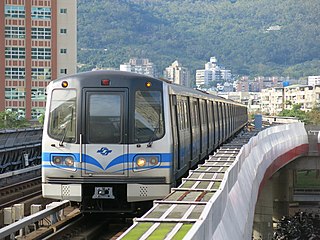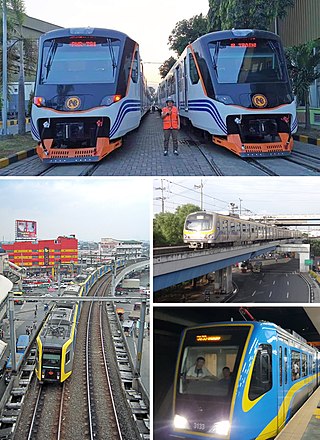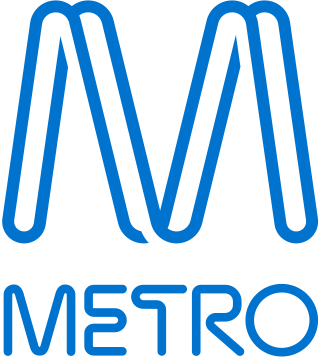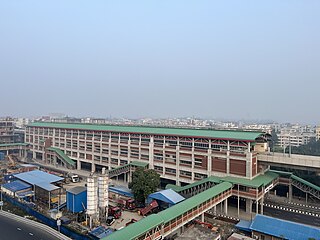
The RATP Group, is a state-owned company (EPIC) that operates public transport systems. Headquartered in Paris, France, the company was formed in 1949 as the Régie Autonome des Transports Parisiens to operate the city's public transport system. While RATP's Paris-related activities are still a major part of its business, its operations have extended since 2002 with the company competing for contracts to operate systems around the world. RATP Dev, the Group's international operations and maintenance subsidiary, is present in 16 countries in Africa, Asia, Australia, Europe and North America.

The Mass Rapid Transit system, locally known by the initialism MRT, is a rapid transit system in Singapore and the island country's principal mode of railway transportation. The system commenced operations in November 1987 after two decades of planning with an initial 6 km (3.7 mi) stretch consisting of five stations. The network has since grown to span the length and breadth of the country's main island – with the exception of the forested core and the rural northwestern region – in accordance with Singapore's aim of developing a comprehensive rail network as the backbone of the country's public transportation system, averaging a daily ridership of 3.4 million in 2019.

The North East Line (NEL) is a high-capacity Mass Rapid Transit (MRT) line in Singapore. Operated by SBS Transit, the 20-kilometre (12 mi) line is the MRT's shortest. It runs from HarbourFront station in southern Singapore to Punggol station in the northeast, serving 16 stations via Chinatown, Little India, Serangoon and Hougang. Coloured purple on official maps, it is Singapore's third MRT line and the world's first fully-automated underground driverless heavy rail line.

The Metropolitan Rapid Transit or MRT is a mass rapid transit system serving the Bangkok Metropolitan Region in Thailand. The MRT system comprises two fully operational rapid transit lines and one fully operational monorail line (Yellow). One monorail line (Pink) is in trial operation, with another rapid transit line (Orange) under construction. The MRT Blue Line, officially the Chaloem Ratchamongkhon Line, between Hua Lamphong and Bang Sue was the first to open in 2004 as Bangkok's second metro system. The MRT Blue line is officially known in Thai as rotfaifa mahanakhon (รถไฟฟ้ามหานคร) or "metropolitan electric train", but it is more commonly called rotfai taidin (รถไฟใต้ดิน), literally, "underground train" as it was distinguished from the BTS Skytrain by being completely underground when its first section between Hua Lamphong to Bang Sue opened.

Taipei Mass Rapid Transit (MRT), branded as Metro Taipei, is a rapid transit system serving the capital Taipei and New Taipei City in Taiwan, it is one of the world's busiest rapid transit systems.

Chennai Mass Rapid Transit System is a metropolitan elevated railway line in Chennai, India. It is operated by Southern Railway of the state-owned Indian Railways. Opened in 1995, it was the first elevated railway line in India and is integrated with the wider Chennai suburban railway network. The railway line runs from Chennai beach to Velachery, covering a distance of 19.34 km (12.02 mi) with 18 stations.

The Metro Rail Transit Line 3, also known as the MRT Line 3, MRT-3 or Metrostar Express, is a light rapid transit system line of Metro Manila, Philippines. Originally referred to as the Blue Line, MRT Line 3 was reclassified to be the Yellow Line in 2012. The line runs in an orbital north to south route following the alignment of Epifanio de los Santos Avenue (EDSA). Although it has some characteristics of light rail, such as the type of a tram-like rolling stock used, it is more akin to a rapid transit system owing to its total grade separation and high passenger throughput.

Rail transportation in the Philippines is currently used mostly to transport passengers within Metro Manila and provinces of Laguna and Quezon, as well as a commuter service in the Bicol Region. Freight transport services once operated in the country, but these services were halted. However, there are plans to restore old freight services and build new lines. From a peak of 1,100 kilometers (680 mi), the country currently has a railway footprint of 533.14 kilometers (331.28 mi), of which only 129.85 kilometers (80.69 mi) are operational as of 2024, including all the urban rail lines. World War II, natural calamities, underspending, and neglect have all contributed to the decline of the Philippine railway network. In the 2019 Global Competitiveness Report, the Philippines has the lowest efficiency score among other Asian countries in terms of efficiency of train services, receiving a score of 2.4, and ranking 86th out of 101 countries globally. The government is currently expanding the railway network up to 1,900 kilometers (1,200 mi) by 2022 through numerous projects.

Rail transport in Singapore mainly consists of a passenger urban rail transit system spanning the entire city-state: a rapid transit system collectively known as the Mass Rapid Transit (MRT) system operated by the two biggest public transport operators SMRT Trains and SBS Transit, as well as several Light Rail Transit (LRT) rubber-tyred automated guideway transit lines also operated by both companies. In addition, local specialised light rail lines are in operation in places such as the Singapore Changi Airport and Sentosa.
In the Mass Rapid Transit system in Singapore, security issues related to crime and terrorism were not high on the agenda of the system's planners since its inception, but since the occurrence of several high-profile terrorism incidents elsewhere, CCTVs have been upgraded and installed across all stations, and security officers patrol inside the trains and within train stations 24/7.

The Jakarta Mass Rapid Transit or Jakarta MRT is a rapid transit system in Jakarta, the capital city of Indonesia.

Rapid transit or mass rapid transit (MRT), also known as heavy rail or metro, is a type of high-capacity public transport that is generally built in urban areas. A rapid transit system that primarily or traditionally runs below the surface may be called a subway, tube, or underground. Unlike buses or trams, rapid transit systems are railways, usually electric, that operate on an exclusive right-of-way, which cannot be accessed by pedestrians or other vehicles. They are often grade-separated in tunnels or on elevated railways.

Metro Trains Melbourne, often known simply as Metro, is the operator and brand name of train services on the electrified metropolitan rail network serving the city of Melbourne, Victoria, Australia. It is the largest urban rail network in Australia, with 17 lines and 219 stations across 405 km (252 mi) of railways, and the second busiest network in Australia, with a patronage of 99.5 million as of 2021–2022.

The MRT Blue Line or MRT Chaloem Ratchamongkon Line is Bangkok's third rapid transit line, following the Sukhumvit line and Silom line of the BTS Skytrain. It is the first of the MRT system and is operated by Bangkok Expressway and Metro (BEM). The original 20 km (12.43 mi) MRT Blue Line from Hua Lamphong to Bang Sue opened on 3 July 2004. A 1.2 km (0.75 mi) extension to Tao Poon opened on 11 August 2017. The 15.9 km (9.88 mi) western extension to Lak Song opened for full service on 29 September 2019 and the 11 km (6.84 mi) extension from Tao Poon to Tha Phra to form the quasi loop, opened for full service on 30 March 2020.

The Dhaka Metro Rail, or simply the Dhaka Metro, is a mass rapid transit system serving Dhaka, the capital and largest city of Bangladesh. It is owned and operated by the Dhaka Mass Transit Company Limited (DMTCL). Together with the under construction Dhaka BRT, proposed Dhaka Subway and Dhaka suburban circular rail, it is expected to reduce traffic congestion in the city. The metro rail network has five planned lines which are the MRT Line 6, the only operational line, MRT Line 1 and 5, which are under construction, and MRT Line 2 and MRT Line 4, which are in the planning stages. It is part of the Strategic Transport Plan outlined by the Dhaka Transport Coordination Authority (DTCA).

The Manila Metro Rail Transit System (MRTS), commonly known as the MRT, is a rapid transit system that primarily serves Metro Manila, Philippines. Along with the Manila Light Rail Transit System and the Metro Commuter Line of the Philippine National Railways, the system makes up Metro Manila's rail infrastructure.

Beep is a reloadable contactless smart card created in 2015 to be a replacement for the magnetic card-based system in paying rail-based rapid transit transportation fares in and around Metro Manila. Beep is also used in lieu of cash in some convenience stores and other businesses. The Beep system is implemented and operated by AF Payments Incorporated, which is primarily owned by Ayala Corporation and Metro Pacific Investments Corporation.
The Metro Manila Subway, formerly known as the Mega Manila Subway (MMS), is an under-construction underground rapid transit line in Metro Manila, Philippines. The 36-kilometer (22 mi) line, which will run north–south between Valenzuela, Quezon City, Pasig, Taguig, Parañaque and Pasay, consists of 15 stations between the East Valenzuela and Bicutan stations. It will become the country's second direct airport rail link after the North–South Commuter Railway, with a branch line to Ninoy Aquino International Airport.

Rail transportation in the Greater Manila Area is a major part of the transportation system in Metro Manila and its surrounding areas. It consists of the Manila Light Rail Transit System, Manila Metro Rail Transit System, and the PNR Metro Commuter Line. The network makes up the majority of active railways in the country and bear the brunt of providing the metropolis with rail as a faster alternative mode of transport other than buses and jeepneys. However, these systems are currently insufficient for the rapidly expanding metropolis; to address this, new lines and line extensions are under construction, which will extend the system far out into neighboring regions.
 MARTA, since 21 April 2023 [9]
MARTA, since 21 April 2023 [9]  Buenos Aires Underground
Buenos Aires Underground  Skyline, since 28 May 2022 [10]
Skyline, since 28 May 2022 [10]  Metro Rio
Metro Rio  Mexico City Metro
Mexico City Metro  Montreal Metro
Montreal Metro  New York City Subway
New York City Subway  OC Transpo, since 15 May 2019 [11]
OC Transpo, since 15 May 2019 [11]  PATH, since 7 April 2022 [12]
PATH, since 7 April 2022 [12]  Santiago Metro
Santiago Metro  São Paulo Metro
São Paulo Metro  San Francisco BART, since 18 January 2018 [13]
San Francisco BART, since 18 January 2018 [13]  Toronto Subway
Toronto Subway  Washington Metro, since 2 January 2018 [14]
Washington Metro, since 2 January 2018 [14]  Vancouver Skytrain, since 30 September 2016 [15]
Vancouver Skytrain, since 30 September 2016 [15]  Bangalore Namma Metro, since 24 February 2020 [16]
Bangalore Namma Metro, since 24 February 2020 [16]  Bangkok MRT
Bangkok MRT  Beijing Subway
Beijing Subway  Delhi Metro
Delhi Metro  Dubai Metro
Dubai Metro  Guangzhou Metro
Guangzhou Metro  Hong Kong MTR
Hong Kong MTR  Kuala Lumpur RapidKL Rail, since 4 November 2013 [17]
Kuala Lumpur RapidKL Rail, since 4 November 2013 [17]  MRT Jakarta, since 30 September 2021 [18]
MRT Jakarta, since 30 September 2021 [18]  Nanjing Metro, since 4 October 2013 [19]
Nanjing Metro, since 4 October 2013 [19]  Seoul Metro, since 1 September 2013 [20]
Seoul Metro, since 1 September 2013 [20]  Shanghai Metro
Shanghai Metro  Shenzhen Metro, since 10 July 2015 [21]
Shenzhen Metro, since 10 July 2015 [21]  Singapore MRT
Singapore MRT  Sydney Metro, since 29 December 2019 [22]
Sydney Metro, since 29 December 2019 [22]  Sydney Trains
Sydney Trains  Tokyo Metro, since 20 January 2020 [23]
Tokyo Metro, since 20 January 2020 [23]  Taipei Metro
Taipei Metro  Barcelona Metro
Barcelona Metro  Berlin U-Bahn
Berlin U-Bahn  Brussels Metro
Brussels Metro  Istanbul Metro, since 20 February 2014 [24]
Istanbul Metro, since 20 February 2014 [24]  Lisbon Metro
Lisbon Metro  London DLR, since 4 December 2013 [25]
London DLR, since 4 December 2013 [25]  London Underground
London Underground  Madrid Metro
Madrid Metro  Newcastle Metro
Newcastle Metro  Oslo Metro, since 23 September 2014 [26]
Oslo Metro, since 23 September 2014 [26]  Paris Métro and Paris RER
Paris Métro and Paris RER  Moscow Metro (membership ceased in March 2022 [ citation needed ])
Moscow Metro (membership ceased in March 2022 [ citation needed ])














